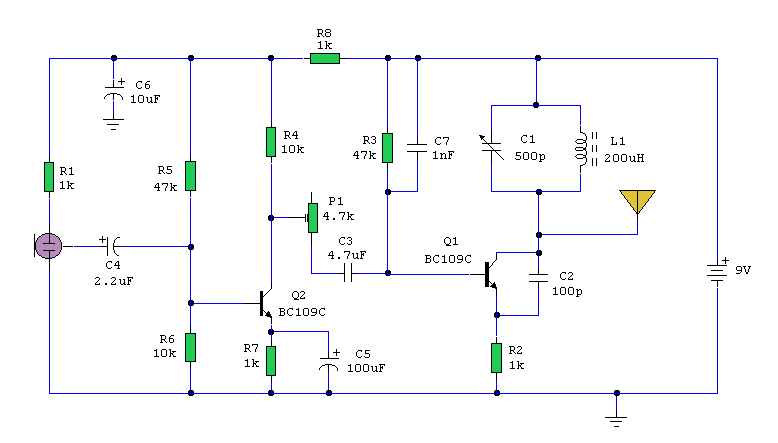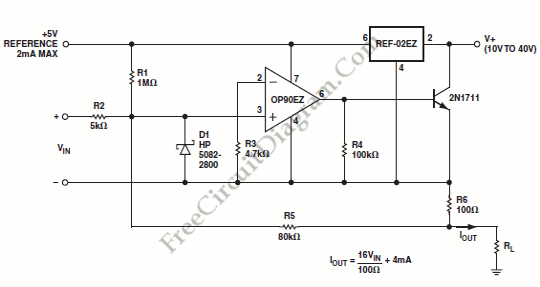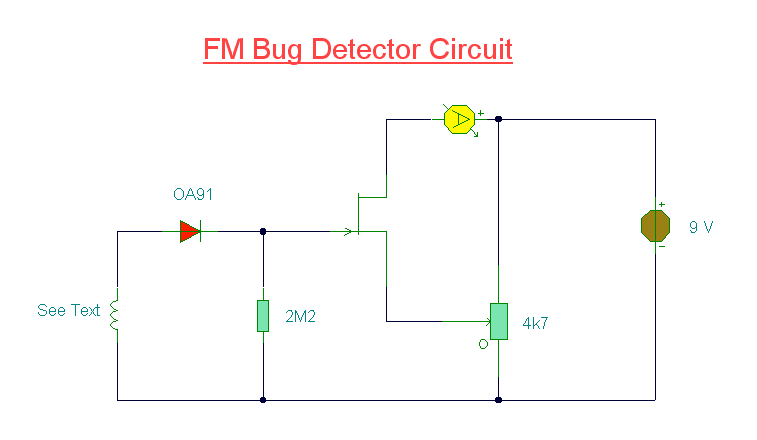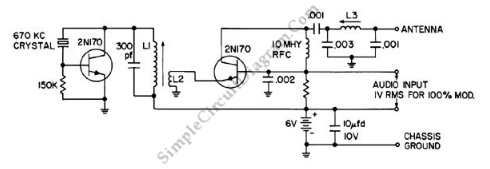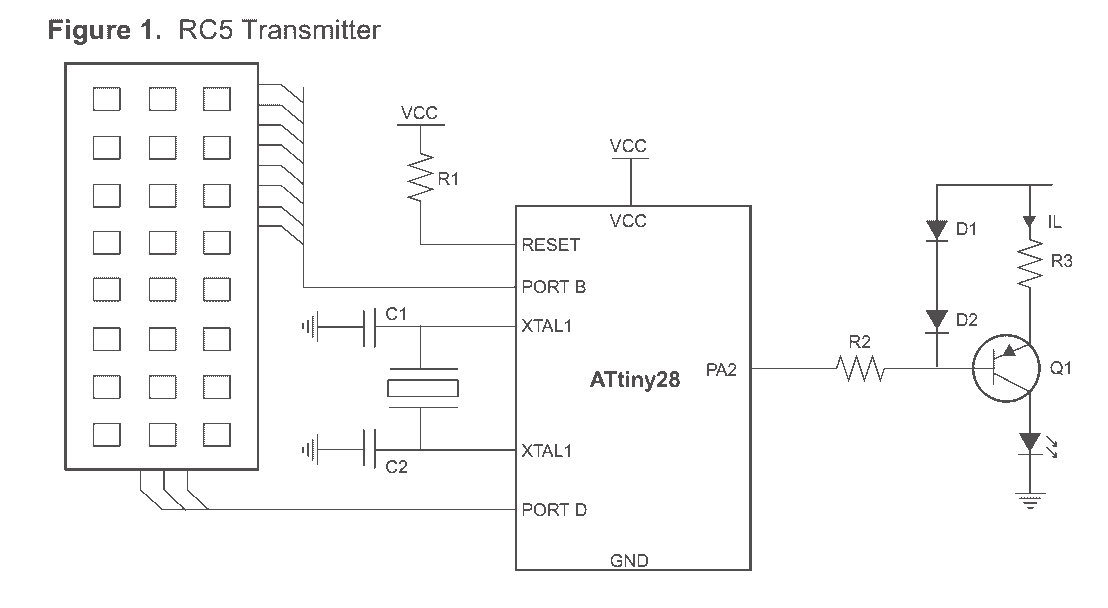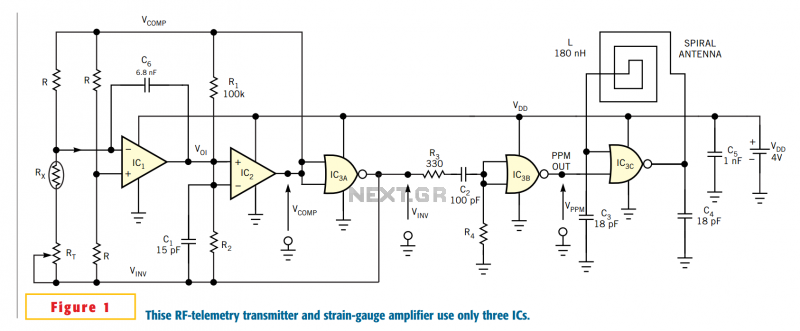
wireless fm transmitter
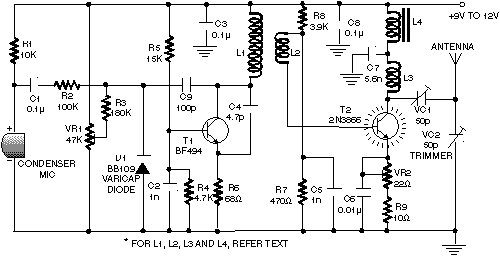
The wireless transmitter circuit utilizes transistor T1 (BF494) as a low-power variable-frequency VHF oscillator. A varicap diode circuit is incorporated to modify the frequency of the FM transmitter and to facilitate frequency modulation using audio signals. The output power of the oscillator is approximately 50 milliwatts. Transistor T2 (2N3866) serves as a VHF Class A power amplifier, enhancing the oscillator's output power by four to five times, resulting in an output power of 200-250 milliwatts at the output of transistor T2. For improved performance, it is recommended to mount the circuit on a high-quality substrate and enclose the transmitter in an aluminum case. The oscillator stage should be shielded using an aluminum sheet. Potentiometer VR1 is used to adjust the fundamental frequency, while potentiometer VR2 functions as a power control. To ensure hum-free operation, the wireless FM transmitter should be powered by a 12V rechargeable battery pack composed of 10 x 1.2-volt Ni-Cd cells. Transistor T2 must be mounted on a heat sink. The transmitter should not be powered on without a connected antenna. Both trimmer capacitors (VC1 and VC2) should be adjusted for optimal output power. Potentiometer VR1 should be set to establish the fundamental frequency near 100 MHz.
The wireless transmitter circuit is designed for efficient operation in the VHF range, primarily targeting FM transmission applications. The use of the BF494 transistor as the oscillator allows for a stable and adjustable frequency output, which is essential for clear signal transmission. The integration of a varicap diode enables frequency modulation, enhancing the transmitter's capability to encode audio signals onto the carrier frequency effectively.
The output stage, utilizing the 2N3866 transistor, is critical for amplifying the weak signals generated by the oscillator stage. This Class A amplifier configuration is known for its linearity, providing a clean amplification of the signal. The specified output power of 200-250 milliwatts is suitable for short-range transmission, making the circuit ideal for personal or hobbyist applications.
Proper assembly and shielding are vital for optimal performance. Mounting the circuit on a high-quality substrate minimizes parasitic capacitance and inductance, which can adversely affect performance. The aluminum enclosure not only provides physical protection but also serves as an electromagnetic shield, reducing interference from external signals.
Potentiometers VR1 and VR2 allow for user adjustments, ensuring that the transmitter can be fine-tuned for specific applications or conditions. The recommendation to use a 12V rechargeable battery pack is practical, as it provides sufficient power while maintaining portability. The heat sink for transistor T2 is necessary to dissipate heat generated during operation, preventing thermal overload and ensuring reliability.
Finally, the caution against operating the transmitter without an antenna is crucial, as doing so can lead to damage from reflected power. The adjustment of trimmers VC1 and VC2 is essential for achieving the best performance, ensuring that the transmitter operates at peak efficiency. Setting the fundamental frequency near 100 MHz places the transmitter within a commonly used FM band, allowing for compatibility with standard FM receivers.The wireless transmitter ambit congenital about transistor T1 (BF494) is a basal low-power variable-frequency VHF oscillator. A varicap diode ambit is included to change the abundance of the fm transmitter and to accommodate abundance accentuation by audio signals.
The achievement of the oscillator is about 50 milliwatts. Transistor T2 (2N3866) fo rms a VHF-class A ability amplifier. It boosts the oscillator signals` ability four to bristles times. Thus, 200-250 milliwatts of ability is generated at the beneficiary of transistor T2. For bigger results, accumulate the ambit on a good-quality bottle adhesive lath and abode the transmitter central an aluminium case. Shield the oscillator date application an aluminium sheet. Potentiometer VR1 is acclimated to alter the axiological abundance admitting potentiometer VR2 is acclimated as ability control.
For hum-free operation, accomplish the wireless fm transmitter on a 12V rechargeable array backpack of 10 x 1. 2-volt Ni-Cd cells. Transistor T2 charge be army on a calefaction sink. Do not about-face on the transmitter after a analogous antenna. Adjust both trimmers (VC1 and VC2) for best manual power. Adjust potentiometer VR1 to set the axiological abundance abreast 100 MHz. 🔗 External reference
The wireless transmitter circuit is designed for efficient operation in the VHF range, primarily targeting FM transmission applications. The use of the BF494 transistor as the oscillator allows for a stable and adjustable frequency output, which is essential for clear signal transmission. The integration of a varicap diode enables frequency modulation, enhancing the transmitter's capability to encode audio signals onto the carrier frequency effectively.
The output stage, utilizing the 2N3866 transistor, is critical for amplifying the weak signals generated by the oscillator stage. This Class A amplifier configuration is known for its linearity, providing a clean amplification of the signal. The specified output power of 200-250 milliwatts is suitable for short-range transmission, making the circuit ideal for personal or hobbyist applications.
Proper assembly and shielding are vital for optimal performance. Mounting the circuit on a high-quality substrate minimizes parasitic capacitance and inductance, which can adversely affect performance. The aluminum enclosure not only provides physical protection but also serves as an electromagnetic shield, reducing interference from external signals.
Potentiometers VR1 and VR2 allow for user adjustments, ensuring that the transmitter can be fine-tuned for specific applications or conditions. The recommendation to use a 12V rechargeable battery pack is practical, as it provides sufficient power while maintaining portability. The heat sink for transistor T2 is necessary to dissipate heat generated during operation, preventing thermal overload and ensuring reliability.
Finally, the caution against operating the transmitter without an antenna is crucial, as doing so can lead to damage from reflected power. The adjustment of trimmers VC1 and VC2 is essential for achieving the best performance, ensuring that the transmitter operates at peak efficiency. Setting the fundamental frequency near 100 MHz places the transmitter within a commonly used FM band, allowing for compatibility with standard FM receivers.The wireless transmitter ambit congenital about transistor T1 (BF494) is a basal low-power variable-frequency VHF oscillator. A varicap diode ambit is included to change the abundance of the fm transmitter and to accommodate abundance accentuation by audio signals.
The achievement of the oscillator is about 50 milliwatts. Transistor T2 (2N3866) fo rms a VHF-class A ability amplifier. It boosts the oscillator signals` ability four to bristles times. Thus, 200-250 milliwatts of ability is generated at the beneficiary of transistor T2. For bigger results, accumulate the ambit on a good-quality bottle adhesive lath and abode the transmitter central an aluminium case. Shield the oscillator date application an aluminium sheet. Potentiometer VR1 is acclimated to alter the axiological abundance admitting potentiometer VR2 is acclimated as ability control.
For hum-free operation, accomplish the wireless fm transmitter on a 12V rechargeable array backpack of 10 x 1. 2-volt Ni-Cd cells. Transistor T2 charge be army on a calefaction sink. Do not about-face on the transmitter after a analogous antenna. Adjust both trimmers (VC1 and VC2) for best manual power. Adjust potentiometer VR1 to set the axiological abundance abreast 100 MHz. 🔗 External reference
